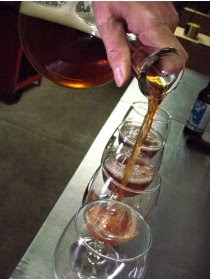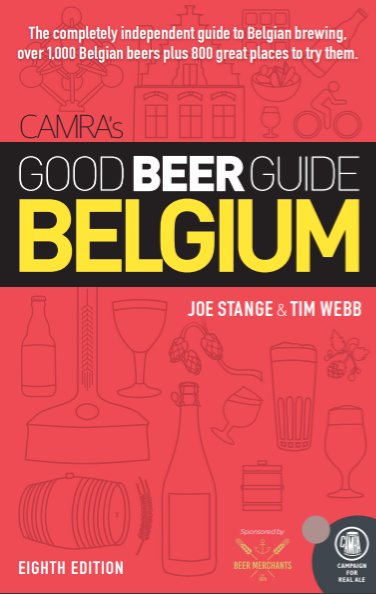This whole beer terroir chatter has the smell of a dog who's not going to leave my porch for a while. So I'm just going to keep feeding him. We'll see what he adds to the family.
Confluence, that's what's going on here. Lots of the people talking about the same thing and not even knowing it. It helps when you can give it a name or two and maybe even build a framework for thinking about it. A point of view. A set of questions to ask over bar chatter, or to employ when you browse the booze shop.
So: If you haven't already, go and read the Stan Hieronymous piece in the latest DRAFT, The Dirt on Terroir. Clicking on that link, by the way, does not excuse you from the good sense of plunking down a few duckets for the print magazine.
I'm not going to recap the whole article, but Stan's quote (circa 2006) from Sam Calagione of Dogfish Head is so juicy I've got to repeat it: "Je parl francais en peu, and I'm pretty sure the translated definition of terroir is 'dirt'. The wine world has wrapped this one word with mighty voodoo powers and created a cult of exclusivity around it. Breweries have terroir as well. But instead of revolving around a patch of land, ours are centered on a group of people."
Stan's kicker: "Don't call it terroir. Call it beer from a place."
 Now, remember that Washington Post article on "Belgium's upstart innovators"? Of course you do. It's the one with the likely-taken-out-of-context quote from Wendy Littlefield of importer Vanburg & DeWulf--the one about how brewers like Alvinne and Struise "really, arguably, are hurting the very culture that they claim to be arising out of."
Now, remember that Washington Post article on "Belgium's upstart innovators"? Of course you do. It's the one with the likely-taken-out-of-context quote from Wendy Littlefield of importer Vanburg & DeWulf--the one about how brewers like Alvinne and Struise "really, arguably, are hurting the very culture that they claim to be arising out of."
Well, the Pour Curator recently had a long and interesting chat with Don Feinberg of V&D, which led to a long and interesting post. Feinberg has been deeply involved with Belgian beer for nearly 30 years, and his thoughts are enlightening. Here is part of the Curator's post, relevant to the aforementioned innovators:
When it comes to some of the new Belgian breweries, to Feinberg, the distinction is one of identity versus geography. Think of it this way: is a restaurant in Thailand necessarily a Thai restaurant? Well, maybe, in a grammatical sense, but if it serves burgers and fries, then not in the sense that most people might mean. Likewise, if a brewery in Flanders is making a great American style IPA, it may be making very good beer, but Feinberg and Littlefield would say it is not Belgian in any meaningful sense, other than strictly geographic.
"There are a couple brewers in Belgium who are making beer for Americans. We’re interested in Belgium, we’re interested in their traditions," Feinberg says. "There are certain flavors that are true to a type of culture, and if you don’t believe that, you’re one step away from making soda."
In my own email chat with Littlefield and Feinberg, which naturally followed that Washington Post article, Feinberg asked if I had read Jonathan Nossiter's
Liquid Memory. I had not. So I bought it two days ago and have been devouring it since--mainly driven by all the obvious parallels (or near-parallels) with the craft beer world.
(In particular it brings to mind all the petty and more or less public squabbles among brewers, critics, lovers and sellers of Belgian beer. On some days, Belgian beer looks like a snake pit in which everyone talks hell behind each other's backs in a propaganda war to impose his or her view on the open-minded and undecided... Probably I've been guilty of that myself. And I'm not even sure I regret it. By comparison, North American craft beer looks like a church camp, complete with hand-holding and
Kumbaya. For the most part, everyone in the North American beer world really
does get along. The trade-off is a relative lack of really strong, critical viewpoints. Is it any coincidence that importers Don Feinberg and Daniel Shelton are two of the most outspoken people on the scene? But surely that's a post for another day.)
I have referred to brewers like Struise, Alvinne, Mikkeller and Brew Dog as not so much Belgian or Danish or Scottish but part of a postmodern, transnational craft beer scene--one for which globalizing forces (such as the Internet) can take some share of the credit or blame. I think it's a fair characterization. With that in mind, here is a snippet from the Nossiter book:
Terroir has never been fixed, in taste or in perception. It has always been an evolving expression of culture. What distinguishes our era is that instantaneousness and universality of change. Before, the sense of terroir would evolve over generations, hundreds of years, allowing for the slow accretion of knowledge and experience to build into sedimentary layers, like the geological underpinnings of a given terroir itself. Today layers are stripped away overnight, and a new layer is added nearly each vintage. "Why is this dangerous?" ask those genuinely eager for progress and modernity, as well as the conscious (or self-deluding) profiteers of this new world order. Because it risks wiping out historical memory, which is our only safeguard against the devastating lies of marketing and the cynical exploitation of global markets, culture and politics.
A lot to digest there. Thoughts?
I don't know whether this dog'll hunt, but at the least I'm taking him with me to the bottle shop next time. With all the options out there today, there are worse ways to narrow things down by sniffing out a
sense of place.















